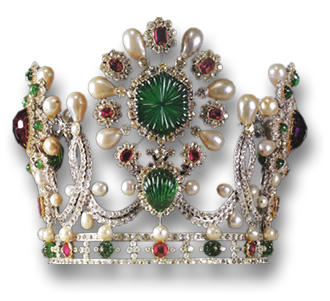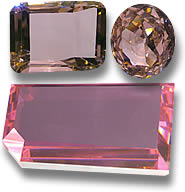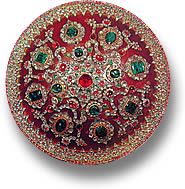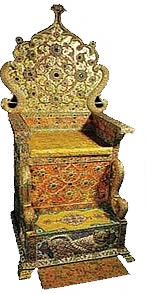The Royal Gems and Jewelry of Iran
 Jewel-Encrusted Crown
Of all the world's treasures, many of the most valuable and impressive belong to the national collection of Iran. Known as the Imperial Crown Jewels of Iran (or Persia), the seemingly endless collection includes a wealth of historical gemstones and jewelry. The incredible collection consists of numerous diamonds, colored gemstones and pearls, both unmounted and mounted. Also included are splendrous jewel-encrusted ornaments, thrones, crowns, tiaras, swords, shields and wearable jewelry, including bracelets, necklaces, pins, pendants, rings and earrings.
The Crown Jewels of Iran are so valuable that the collection is actually used to back the Iranian national currency as a reserve fund. Many of the items included in the collection were acquired centuries ago during the Safavid Dynasty, which reigned from 1502 to 1736 AD. Nader Shah Afšar is credited with collecting most of the jewels during his Persian conquests. Some of Nader Shah's most significant acquisitions include the Koh-I-Noor diamond, the Darya-ye Noor diamond and the Peacock Throne.
 |
| Noor-ol-Ein; Daryayeh-E-Noor; Great Table Pink Diamonds |
The Koh-I-Noor diamond or 'the mountain of light' was acquired by Nader Shah through one of his Persian conquests, but after his assassination in 1747, it was eventually passed on through many hands before it was finally surrendered to the Queen of England where it still remains to this day. The Daryayeh-I-Noor, also known as 'the sea of light', is the sister diamond of the Koh-I-Noor (both mined from the Paritala-Kollur Mine in India) and is one of the largest known cut diamonds in the world.
The Daryayeh-I-Noor is an incredibly rare pale-pink diamond that weighs roughly 182 carats. It is believed that the Daryayeh-I-Noor is one of two pieces of a bigger diamond formerly known as 'the Great Table Diamond', which belonged to the late Mughal emperor, Shah Jahan. The 2nd piece of the Great Table diamond is believed to be the Noor-ol-Ein diamond, a 60-carat pink diamond that is presently featured in a royal tiara belonging to the Iranian Imperial collection.
 |
| Imperial Shield with Gemstones |
Other famous items in the Imperial Iranian Jewelry Collection include the Pahlavi Crown, a crown featuring 3380 diamonds, 369 natural pearls and numerous large emerald and sapphire gemstones, some as large as 100 carats. The Naderi Throne is made of wood, coated with gold and studded with jewels. The 23K gold throne is decorated with nearly 27,000 gemstones, mostly ruby, diamond and emerald. It was built from twelve sections that could be taken apart and reconstructed to accompany the King on his travels.
The Great Globe is an extravagant 35 kilogram pure gold globe studded with over 51,000 gemstones, including seas made of emerald and earth made mostly of ruby and some spinel. Several regions and countries are encrusted with diamonds, including Iran, England and France. The Imperial Sword, also known as the Shahi Sword, is world-famous for its exquisite bejeweled decoration. The 103 centimeter long sword is encrusted from handle to hilt with approximately 3,000 various gemstones, including rare emeralds, diamonds, rubies and spinel. Its sheath is also impressively studded with hundreds of gems, as well as the matching shield. There are many other exquisite pieces of jewelry on display, many of which were used in coronation ceremonies.
 |
| Imperial Jeweled Throne |
The Imperial Iranian Crown Jewel Collection is housed and displayed at The Treasury of National Jewels located inside the Central Bank of the Islamic Republic of Iran, on Tehran's Ferdowsi Avenue. This Iranian gem and jewelry exhibition is the world's largest state-owned collection of jewelry on display. For centuries, the crown jewels were stored in the vaults of the Imperial Treasury, away from public view, but because of the royal decree issued by Mohammad Reza Pahlavi Shah, the finest pieces were displayed for the public to see. The Pahlavi Dynasty was the last to use the Imperial Crown Jewels and it is because of Pahlavi that the collection garnered wide-eyed attention from the Western world. Although many items were looted during the Iranian Revolution in 1979, most of the collection remained intact and is still on display today.
|
